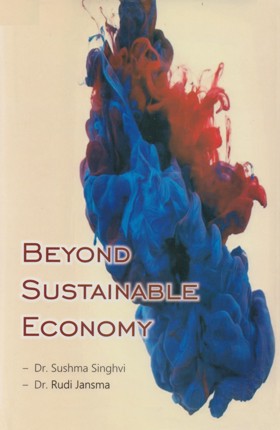Dr. Christopher Key Chapple[1]
In our contemporary culture, we suffer from all the maladies identified by Woolman, which were discussed in the article John Woolman - American Quaker in this volume [Section 8]. Juliet Schor has named this tendency "competitive consumption," defined as:
the idea that spending is in large part driven by a comparative or competitive process in which individuals try to keep up with norms of the social group with which they identify.... What's new is the redefinition of reference groups: today's comparisons are less likely to take place between or among households of similar means. Instead, the lifestyles of the upper middle class and the rich have become a more salient point of reference for people throughout the income distribution. Luxury, rather than mere comfort, is a widespread aspiration.[2]
She points out that since the rise of television, people spend less time with family and friends and receive their base-line definition of "normal" through the media. For the upper 20% of the American population which controls over 84% of the nation's wealth, conspicuous spending has become the norm:
Trophy homes, diamonds of a carat or more, granite countertops, and sports utility vehicles now are the primary consumer symbols. Television, as well as films, magazines, and newspapers, ensure that the remaining 80 percent of the nation is aware of the status purchasing that has swept the upper echelons.[3]
In a pithy description of the amount of work required to stay in the upper echelons of wealth, Schor, almost in response to the challenge put forward by John Woolman, writes:
The new consumerism, with its growing aspirational gap, has begun to jeopardize the quality of American life. Within the middle class, and even the upper middle class, many families experience an almost threatening pressure to keep up, both for themselves and their children. They are deeply concerned about the rigors of the global economy, and the need to have their children attend "good" schools. This means living in a community with relatively high housing costs. For some households this also means providing their children with advantages purchased on the private market (computers, lessons, extracurriculars, private schooling). Keeping two adults in the labor market - as so many families do, to earn the income to stay middle class - is expensive, not only because of the second car, child care costs, and career wardrobe. It also creates the need for timesaving, but costly, commodities and services, such as take-out food and dry cleaning, as well as stress-relieving activities. Finally, the financial tightrope that so many households walkhigh expenses, low savingsis a constant source of stress and worry.[4]
Beyond the personal implications of the stress-inducing aspects of overweening consumerism, the rate and volume of American possessiveness weighs heavily on the environment. Schor notes:
Whatever we consume has an ecological impact, whether it's the rainforests cleared to graze the cattle which become Big Macs, the toxins collecting in our bodies from the plastics that now dominate our material environments or the pesticides used to grow the cotton for our T-shirts... Americans know very little about the ecological impacts of their lifestyles.... We are oblivious to some of our most damaging consumer habits: air conditioning, jet travel, meat, household toxins, and the sheer volume of resources consumed each day (120 pounds).[5]
The indigenous peoples of Los Angeles wove shelter from reeds, gathered fish from the ocean, and ate in dishes made of abalone shells. The remnants of their material culture consist of grinding stones and pestles made from rock, left over from the process of producing acorn meal from the abundant oaks. By contrast, the modern American generates pound after pound of non-degradable plastic disposable containers, and will leave behind countless and largely uninteresting cultural legacies, largely entombed in vast landfills. We live in throw-away times. Now merely household garbage, but the house itself (often replaced by a mansion) gets hauled off and dumped in a seemingly remote, but all-too-near once-bucolic canyon.
All of this preoccupation with the possession of things comes at a great cost. The dawn of the personal computer was hailed as the first step of a "paperless" way of doing business. Yet, not only has office paper consumption increased, nearly every household needs to make occasional trips to Office Depot or Staples to replenish the ever-hungry home printer with ink (in disposable plastic gizmos, not accepted for recycling) or a ream of paper.
With the Internet, one is not quite certain how to interpret the thingness of things. Rather than pining for a new CD, my teenage son whines that we need more gigabytes to download music more quickly. Even in this emerging virtual reality, there is a price to be paid, in terms of work hours, cash, and the loss of human-to-human contact engendered by electronic distractions. Additionally, our wealth has further exacerbated human distancing. As Schor notes, "Fifty years ago, only 20 percent of all [American] houses had more rooms than people living in them; by 1970, over 90 percent of our homes were spacious enough to allow more than one room per person."[6] This isolation of family members while affording the privacy one certainly craves and rarely had as a child, limits the accountability of parents to children, and children to parents. Some homes allow children to have their own private TV in their room, not only fostering isolation but increasing a child's exposure to the clever marketing ploys of greedy advertisers. In a study of Telecom employees, Juliet Schor discovered:
Television viewing results in an up-scaling of desire, and that in turn leads people to buy - quite a bit more than they would if they didn't watch. In the Telecom example, I found that each additional hour of television watched in a week led to an additional USD 208 of annual spending... Sitting in front of the television five extra hours a week raises that spending by about USD 1000.[7]
Children, when exposed to television, face a constant barrage of product information, even while watching 'educational' programming such as Animal Planet. Having been trained as consumers from a young age, these people become trained to be customers, shoppers, continuing the cycle.
Two factors raise an alarm for concern. The ultimate nature of God is radical simplicity - the truths to be gleaned are eminently practical. The acquisition of things does not necessarily entail an increase in one's wisdom or happiness. Quite the contrary; studies have shown an inverse relationship between wealth and happiness in both Japan and the United States, once the basic necessities of life have been fulfilled.[8] The second entails the often irreparable harm done to the environment as a result of consumerism, not only in terms of items that end up in the trash heap, or suspended in the atmosphere, but the more intangible 'consumables' such as travel and tourism. In Goa, India, studies have been conducted that conclude that foreign tourists absorb scarce resources and actually diminish the local economy. Activists in India are seeking to curb visitors as a result. Consumerism extends beyond the material to the craving for exciting experiences, often sought at great cost.
The Quakers' simple way of living has been largely left behind by the Quakers themselves, who by the 19th century had become prominent land holders and industrialists, both in America and England. Yet, some people of all backgrounds are creating a consumer revolt. Rather than being driven by an ideology - Marxist, Buddhist, or Christian - they seem to simply be fed up with the pace of life required to fulfill all the consumerist expectations fostered by advertising and the culture at large. Juliet Schor notes that "between 1990-1996, 19 percent of all adult Americans made a voluntary lifestyle change, excluding a regularly scheduled retirement, that entailed earning less money."[9] In contrast to the countercultural movement of the 1960s, she notes that "downshifters are not dropping out of society, few are living communally, and most are not ideologically motivated."[10] She cites in particular the laid-back, nature-oriented Northwest, where thrift stores, purchasing co-ops, and a general disdain for high fashion have made simple living doable on more than an involuntary basis. This requires a shift away from vulnerability to marketers, the development of a supercilious attitude toward the cult of celebrity, and an acceptance of life's simple pleasures. Schor writes:
In contrast to those caught up in the competitive spending process, simple livers struggle against the dominant cultural assumptions about consumption, continually chipping away at the symbolic meanings of consumer objects. They reject the idea that their worth as a person is determined by the size of their house, or that they are incomplete without good china and a silver service. They symbolically connect their cars with pollution rather than power and sexuality. They no longer feel they have to appear in society in first-run clothes.[11]
By diminishing consumption, more time can be available for community service work and, for those who are capable, more resources can be donated to charitable causes. For personal, social, and ecological reasons, simple living and a reduction of one's possessions can help facilitate a refocusing on matters of far greater concern.
Navin and Pratima Doshi Professor of Indic and Comparative Theology, Loyola Marymount University, Los Angeles.
Juliet Schor. The Overspent American: Why We Want What We Don't Need. (New York: Harper Perennial, 1998) p. 108, 156.
 Dr. Christopher Key Chapple
Dr. Christopher Key Chapple
 Dr. Rudi Jansma
Dr. Rudi Jansma
